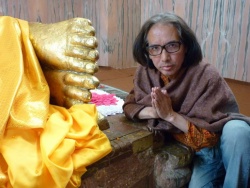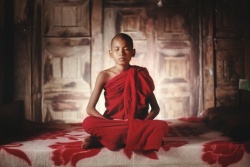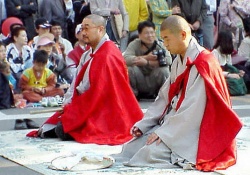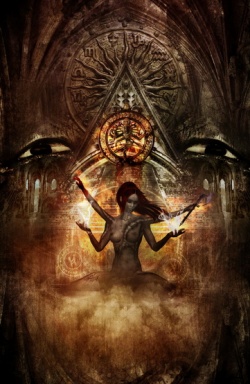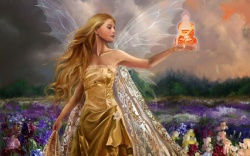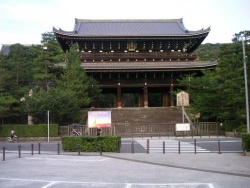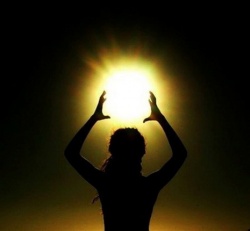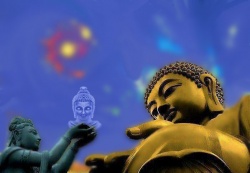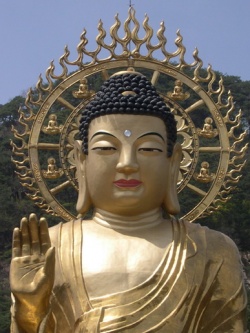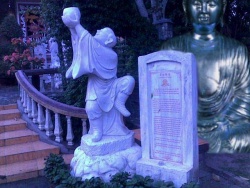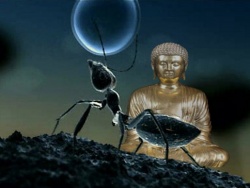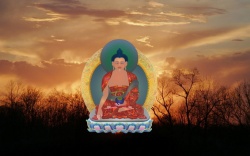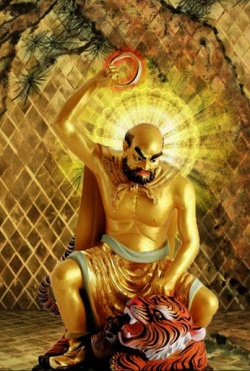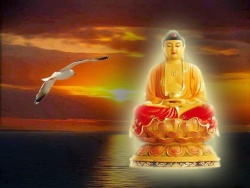Drala
Drala (Wyl. dgra bla or sgra bla) or dralha (Wyl. dgra lha) — dynamically active non-human beings inhabiting the air element, who are usually invisible to ordinary human perception.
They form the retinue and agents of Gesar and are usually portrayed as wild, fearless warriors on horseback.
As Orgyen Tobgyal Rinpoche makes clear, the inner aspect of drala is connected to the subtle energy system in the body, and the ‘secret’ aspect to the nature of mind.
Drala may be spelt two ways: ‘drala’ and ‘dralha’.
These suggest two ways in which the inner aspect can be understood. ‘Drala’ connects it to la, one of the fundamental life-forces; so it can be seen as an aspect of our life-force which functions to protect us from our ‘enemies’.
‘Dralha’ connects it to lha, ‘deity’.
This term should be understood to signify simultaneously both a natural force operating in the phenomenal world, and an aspect of our own pure awareness.
Early spellings of the term suggest connections both with using sound (sgra) to arouse la (bla) (which is perhaps one reason why windhorse practices are usually recited loudly), and with controlling the flow of prana in the channels.
Namkhai Norbu Rinpoche explains the term as follows:
where la (soul or vitality) stands for a type of individual energy that is also endowed with a protective function.
In more recent texts, notably those of the Buddhist tradition, we find the spelling dgra lha, 'deity of the enemy', a term which has been interpreted to mean a warrior deity whose task is to fight one's enemies. [...]
Other authors, interpreting the term in the sense of 'deity that conquers the enemy's la' have instead spelt it dgra bla, 'enemy's la'.
- [...] The spelling sgra bla ('la'' of sound') found in the ancient texts as a matter of fact is based on a very deep principle characteristic of the most authentic Bön tradition.
Sound, albeit not visible, can be perceived through the sense of hearing and used as a means of communication, and is in fact linked to the cha (the individual's positive force, the base of prosperity),
wang tang (ascendancy-capacity), and all the other aspects of a person's energy, aspects that are directly related with the protective deities and entities that every person has from birth.
Moreover, sound is considered the foremost connection between the individual himself and his la.
From all this we can easily understand the deep meaning of the word sgra bla.[1]
Footnotes
- ↑ Namkhai Norbu, Drung De'u and Bön, translated by Adriano Clemente, Library of Tibetan Works and Archives, 1995 pp.61-62
See Also
(Tibetan: "dra", enemy or opponent; "la", above): "beyond the enemy". "
Unconditioned wisdom and power of the world that are beyond any dualism, therefore Drala is above any enemy or conflict. It is wisdom beyond aggression.
It is the self existing wisdom and power of the cosmic mirror that are reflected both in us and in our world of perception."
"One of the key points in discovering drala principle is realizing that your own wisdom as a human being is not separate from the power of things as they are... reflections of the unconditional wisdom of the cosmic mirror. ...
When you can experience those two things together...then you have access to tremendous vision and power in the world...connected to your own vision, your own being. We actually perceive reality.
Any perception can connect us to reality properly and fully." (pg 103)
"The dralas are elements of reality:
anything that connects you with the elemental quality of reality, anything that reminds you or the depth of perception.
Dralas are in the rocks...trees...mountains... a snowflake or a clod of dirt.
What ever is there...those are the dralas of reality. when you make that connection...you are meeting the dralas on the spot. (pg 105)
"The basic definition of Drala is 'energy beyond aggression'." (pg 108)
INVOKING DRALA: "If we are thoroughly trained in the disciplines of warrior-ship,then by invoking the drala principle, we can reawaken that intimate connection to reality." ...
"When you invoke drala, you begin to experience basic goodness reflected everywhere-in yourself, in others, and in the entire world." ... you begin to view the universe as sacred world." (126)
"You see that you can actually organize your life in such a way that you magnetize magic, or drala, to manifest brilliance and elegance in your world.
The way to do this is divided into three parts, which are called the three ways to invoke drala."
External Drala:
"Invoking magic in your physical environment; how you organize and care for your space is creating harmony in your environment in order to encourage awareness and attention to detail, promoting the discipline of warriorship."
Internal Drala:
"Invoking drala in your body." "Basically, the experience of internal drala is that you feel oneness in your body-oneness in the sense that your head, your shoulders, your torso, your arms, your genitals your knees, your legs, and your toes hang together as one basically good human body.
All of your sense perceptions work as one unit, as one basic goodness, one expression of basic health."
Secret Drala:
"Secret Drala is the product of invoking the external and internal drala principles.
Because you have synchronized sacred environment and your body so beautifully, you provoke tremendous wakefulness and nowness in your state of mind."
Secret Drala is experiencing that very moment of your state of mind, which is the essence of nowness.
You actually experience being able to connect yourself to the inconceivable vision and wisdom of the cosmic mirror on the spot. ...
you realize that this experience of nowness can join together the vastness of primordial wisdom with both the wisdom of past traditions and the realities of contemporary life. ...you begin to see how the warrior's world of sacredness can be created altogether." (pg 113-115)
There are various levels of experiencing drala.
The primordial or ultimate level of drala is experiencing directly the wisdom of cosmic mirror."
"The inhabitants of the cosmic mirror." (pg 174) Ultimate Drala "the imperial rulers of Shambhala, who are called the Rigden Kings are the inhabitants of the cosmic mirror.
They are the primordial manifestation of the wisdom of vast mind, the ultimate wisdom of drala.
Therefore they are referred to as ultimate drala.
Ultimate Drala has three characteristics [or qualities]."
Three Qualities of Ultimate Drala:
"First it is primordial,...going one step beyond before we ever think of anything at all."
"The second quality is unchangingness. There are no second thoughts...
The third quality of ultimate drala is bravery."
"...Once having made a connection to ultimate drala, it is possible for the primordial wisdom and vision of the Rigden Kings to be passed down to the level of human perception....
the vastness of perception can be captured in simplicity, a single perception, on the spot.
When we allow vastness to enter our perception, then it becomes drala; it becomes brilliant and luminous - magical.
When we have this experience, then we are meeting what are called the inner dralas...empowered by the wisdom of the Cosmic Mirror, the Rigdens, to manifest brilliance and elegance in this phenomenal world.
The inner dralas are divided in to the mother lineages and father lineages."
[The Two Lineages of Inner Drala
The "Mother lineage represents gentleness,
the Father lineage represents fearlessness... (pg 175)
The third quality of inner drala is intelligence or discriminating awareness, which binds together gentleness and fearlessness.
With discriminating awareness, gentleness is not ordinary gentleness, but it becomes the experience of sacred world.
And fearlessness goes beyond bravado to manifest elegance and richness in a person's life.
So the basic sharpness of awareness binds gentleness and fearlessness to create the warrior's world of vast but appreciative perception." (pg 176)
"The best and only way to invoke Drala is by creating an atmosphere of bravery." (pg 108) "By invoking the external and internal drala principles, you raise a wind of energy and delight in your life.
You begin to feel natural power and upliftedness manifesting in your existence. Then, having raised your windhorse, you can accommodate whatever arises in your state of mind.
There is no problem or hesitation of any kind. So the fruition of invoking secret drala is that having raised windhorse, you experience a state of mind that is free from subconscious gossip, free from hesitation and disbelief.
You experience the very moment of your state of mind. It is fresh and youthful and virginal.
That very moment is innocent and genuine. It does not contain doubt or disbelief at all. It is gullible, in the positive sense, and is completely fresh. Secret Drala is experiencing that very moment of your state of mind, which is the essence of nowness.
You can actually experience being able to connect yourself to the inconceivable vision and wisdom of the cosmic mirror on the spot.
At the same time, you realize that this experience of nowness can join together the vastness of primordial wisdom with both the wisdoms of past traditions and the realities of contemporary life.
So in that way, you begin to see how the warrior's world of sacredness can be created altogether." (pg 114-115) "Bravery means you are not giving in even to any potential doubt; in fact, there is no room for any doubts whatsoever in this realm. (see Bravery)
